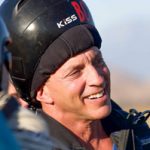The twelfth chapter in Dan BC’s 4-way manual… keeping the team together

Good communication and awareness is essential
KEYING – SIGNALING TO BREAK FORMATIONS
Formation skydiving teams move with precise timing and synchronicity. The primary tool used to hold the team together and keep them in synch is the speed at which they signal to break, (“key”) a formation.
The goal of the first step of a team’s training is to learn to skydive as one team instead of four individuals. Learning to tell when the team is ready and keying at the right time is a huge factor in accomplishing this.
The correct “key speed”, the speed at which to break formations, can change point by point and will evolve throughout a team’s development. It is not as simple as just keying when the last grip is on, or when the formation is flying tension-free, or just going on rhythm. Keying too fast can make the team feel rushed and panicked. It will push the team over the line and can lead to a major breakdown. Keying too slowly wastes time and takes away from the energy of the jump.

When to key?
So, what is the right time to key? The answer is quite simple, key when everyone is ready to go. It is the key person’s job to learn to read the readiness of the team. This is done by the team communicating with good eye contact as well as solid grips. The primary key person is the Rear Center flyer. This is because they are most often in the position where they can easily see and feel everyone on the team and tell if they are ready for the key or not.
It takes longer for a younger team to be ready for the key than for an experienced team. A very new team may not be ready to transition until everyone has a good grip, the formation is completely stopped and all eyes are on the key person. The most experienced teams should be ready the instant that the last finger comes in contact with a legal grip. At all levels good communication and awareness is essential.
Good communication and awareness is essential”
When a team flies sharply and cleanly, everyone can tell during the transition that the formation is building well and that the team should be ready to go. The key person recognizes before he even has a grip that he will be able to key quickly and he knows the team will be expecting it.
If the team has a rough transition the formation won’t build as well and they won’t be ready to go as soon. But with good eye contact and awareness the team will recognize this during the transition. They will see that the formation is not building as well and will expect that the key person will probably have to ‘squeeze the point’. In either scenario the team is able to stay together and fly as one.
Knowing what to expect
Knowing what to expect from the key person has a very calming, confidence-building effect on the whole team. If someone has a brainlock or is late getting on grips, they know there is no reason to panic because the key person has them covered and won’t go without them. On the flip-side, when the jump is going smoothly they will expect that the key person recognizes the team is ready to go sooner and will take advantage of it by picking up the pace.
Knowing what to expect from the key person has a very calming, confidence-building effect”
There may be times that a formation is nearly unstable, or someone barely has a grip but the team is aware of the problem and is ready to go. They may not like the situation but they see what is happening and know what they need to do in response.
For instance, consider a situation where the key person can see that the Front Center barely has a grip on the Point flyer. But the front Center is holding his hand perfectly still to show stationary contact. Rear Center knows Front Center is ready because he is not trying to pick up a better grip. The Front Center knows the grip they have will look legal to the judges and on the key will flash hard with both hands. The formation may not have been pretty, and was barely even complete, but it looked legal and was ready to key.
The exact same is true if Tail has a weak grip on the back of Rear Center. The Rear Center at first may feel the grip moving as the Tail tries to get a better hold. He knows Tail isn’t ready to go. When he feels the weak grip freeze he knows Tail has decided to go with the grip they have. He keys, Tail flashes and they go to the next point.
Another scenario would be when a block closes off-level and with too much speed. It finishes on grips and the team locks it down to stop it. But it is still several feet off level. Everyone sees the level problem. They know that immediately on the key they need to fix the levels as they move to the next point. They are ready to go. It will take less time to key it and move than it would to hold the formation and fix the levels while still on grips.
On the other hand, if someone wasn’t aware of the level problem they wouldn’t know what was going to be required to fix it, they’re not ready. Choosing to key it could result in a problem that takes much more time than fixing it while on grips in the formation. Under this scenario it would be better to hold off on keying.

Training Readiness
To understand exactly when the team is ready and to get the most benefit out of the key speed it is important to address it when reviewing the jumps. Let the key person know if the team is ready earlier than he thinks. Let individuals know if they weren’t ready when they should have been.
Ultimately, and sooner much rather than later, if your hands are touching the grips you better be ready. Train your eye contact and anticipation skills so that you see everything and are always a step ahead.
It is essential you have a clear picture of the ultimate goal but you cannot begin at the finish line”

BUILDING THE FOUNDATION
It is essential that you have a clear picture of the ultimate goal you are trying to reach but you cannot begin at the finish line. Every well thought out training plan begins with building a strong foundation of basic skills, disciplines, work ethic, and attitude. Building a strong foundation for the team will allow you to reach much higher down the road.
Do not underestimate the importance of this. You can only reach as high as your foundation is strong enough to hold. If you try to reach for performance levels before your foundation of basic personal and team skills is strong enough you will forever be in a cycle of taking two steps forward and one step back. Or possibly one step forward, two steps back. But if your foundation is strong you will be able to layer new skills on one at a time and continue a steady climb towards reaching your goal.
Photos in this article, by Niklas Daniel, show Storm World Champion 4-way team, trained by Dan BC
More Magic From Dan
Previous Article (11): Understanding 4-way Slots
Next Article (13): Randoms
Above All Else

Several articles in this series are extracts from Dan’s amazing book, ‘Above All Else’, which covers far more than skydiving. It’s available from Square One HERE or Amazon HERE, where you can check the glowing reviews, mostly from non skydivers, such as:
“I can’t recommend the book more. Do yourself this favor and just read it. Sure, it’s not Shakespeare, but it’s truth. At 120 MPH. And you will be forever changed.”
Amazon review by Esta Desa



